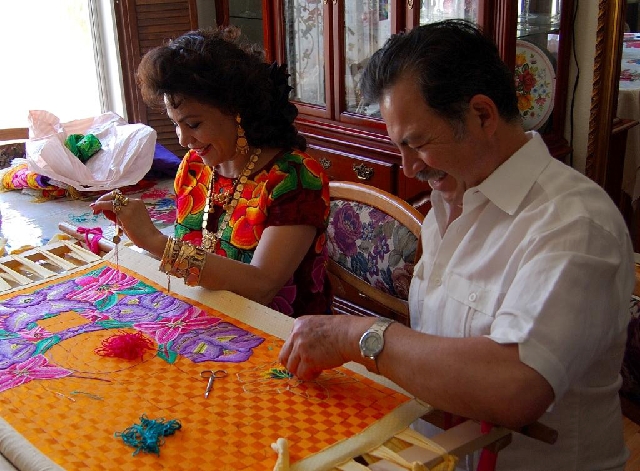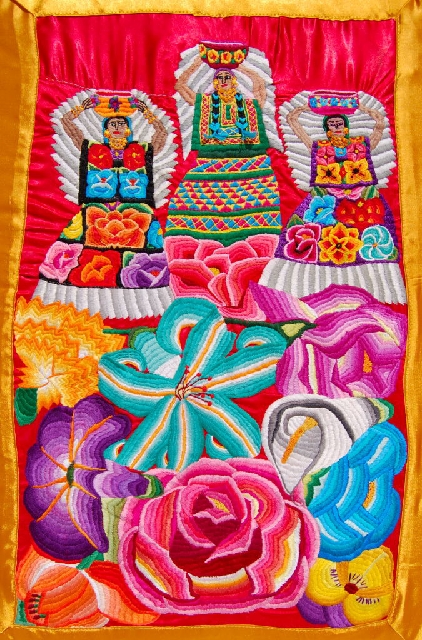Father’s handiwork a personal gift from his ancestors to his children
For Romeo Sigüenza, it is not just the dance but the skirt that enlivens memories of his grandmother and the ancestors he left behind in southern Mexico. Born on the Isthmus of Tehuantepec, Sigüenza brought with him to the United States his insights into the meaning and significance captured in the vibrant colors and striking symbols of the needlework embroidered in family traditions.
The intricate and colorful embroidery of the Las Vegas folk artist and members of his family is featured in Family Flowers/Flores Familiares, a new exhibition at the Nevada State Museum in Las Vegas.
The exhibit will begin June 16 and be on display through the end of the year. It includes handmade, regional traditional costumes and lavishly embroidered clothing passed down from Sigüenza’s relatives.
“I am an embroiderer. In Mexico, embroidery is a family vocation. You put the cloth in a big hoop, and everyone from the 7-year-old child to the 90-year-old grandmother sits around it and embroiders,” he said.
“My daughter grew up here, in the United States, but I taught her to embroider. In my family, to be the firstborn is special. My mother is the firstborn, and my grandmother, and I am the firstborn. And so it was my turn to inherit the family history.”
The exhibit, with bilingual interpretive panels, tells a story of how traditional arts are maintained and passed down in families from one generation to the next. Folk arts are often associated with particular places or nationalities, but in fact it is people — tradition-bearers and their families — that keep folk art traditions alive and strong, wherever they reside.
“Folk arts are not scientific or analytical. They represent a different kind of knowledge that is transmitted from one person to another, laden with shades of significance and belief, and charged with the power of memory and emotion.
“The art is rooted in the past, but not defined by it,” said the Arts Council’s Rebecca Snetselaar. “Folk arts are like favorite flowers, family flowers — cultivated and cherished in hearts and minds, passed down through generations, traveling with immigrant families across oceans and continents to adapt and bloom in an unfamiliar environment — a new home,” Snetselaar said, describing the significance of the exhibit’s name.
“The ‘Flores Familiares’ exhibit is our first collaboration with the Arts Council in our new home on the grounds of the Springs Preserve. We are so looking forward to sharing this and all our wonderful exhibits with the Las Vegas community, visitors and people who are connected to this Mexican tradition,” said Dennis McBride, museum director.
There will be a free reception for the exhibit’s opening at the museum June 16 from 2 to 5 p.m. Family Flowers includes a selection of Sigüenza’s traditional handmade clothing from Oaxaca and neighboring states, including the tehuana dress from Oaxaca, made famous by artist Frida Kahlo in the 1940s; a gala dress, embroidered in tulle, from San Cristobal de Las Casas in Chiapas; the terno, a lavishly-stitched three-piece white dress worn in Yucatan; and the beloved china poblana sequined dress from Puebla.
Since ancient times there have been many distinct cultures in what is now the Mexican state of Oaxaca, each with its own language and dialects, ancestral traditions and regional styles of dress.
The folk arts used to create these traditional garments — needlework, weaving, and use of natural dyes — have survived for hundreds of years.
Today, in Nevada, people still dress in traditional clothing from their Mexican homelands for special occasions, festivals, celebrations and ballet folklorico Mexican folk dance performances.
Sigüenza’s family collection of embroidered textiles from Juchitán and Tehuantepec has expanded over his lifetime to include vintage handmade garments from neighboring regions and states, including many elaborate huipils, colorful, flowery creations worn as a blouse or tunic.
“The person who puts it on will wear a garment that’s almost magical. Because the flower is life and life is strength and power,” Sigüenza said. “We believe that through flowers you receive the sun’s energy. The flower takes it from the sun and the person takes it from the flower.”
Through the years, the outfits continue changing, he said. “It’s like a fashion, new kind of thread, a new design.” A long time ago, women did not wear a long huipil, but Spanish authorities would not allow them to wear short ones.
Hundreds of years ago, they used jade, turquoise, coral or pearl to make the designs along the bottom edge of the piece. Today, it is made with glass beads, Sigüenza said.
“Our changing gallery is a perfect place to show these beautiful costumes and fabrics. The colors are spectacular. We had the Costume Society of America here as the display was installed and it was a pretty historic occasion for us to be part of. It brought a diverse group together, to experience a wonderful example of family tradition,” McBride said.
Sigüenza’s own family is portrayed in the exhibit as well. “One of my designs is a ceremonial or family panel, like a photo of my family. There are the three important women in my life: my grandmother, my wife, and my daughter,” Sigüenza said.
He depicts them, along with flowers, in one of the exhibit’s pieces. Before embroidering a huipil, the artist asks permission from God to take a little of the spring from nature and put it in the material.
It is not just a work with hands, threads and needles, Sigüenza said, it is a work with the soul, the spirit and heart. When people embroider a huipil, they put all their love into the work, and give it all of their attention.
“My great-grandmother was a wise person who knew a lot about natural medicine, prayers, customs, clothing and food. I remember the stories she told me, and I was lucky to have lived and grown up with her, because that is how I was able to receive the gift of her knowledge,” he said.
“Just as my grandparents gave this gift to me, I will entrust it to my granddaughter and she will pass it on to her children.”
The Nevada State Museum Las Vegas is open from 10 a.m. to 6 p.m. Friday through Monday at 309 S. Valley View Blvd.
All ages are welcome. For information, contact the museum at 702-486-5205, go to www.nevadaculture.org or visit Facebook at www.facebook.com/nsmlv.
Normally admission is $9.95 for Nevada residents; children 17 and younger are free. The Father’s Day event June 16 is free.

















